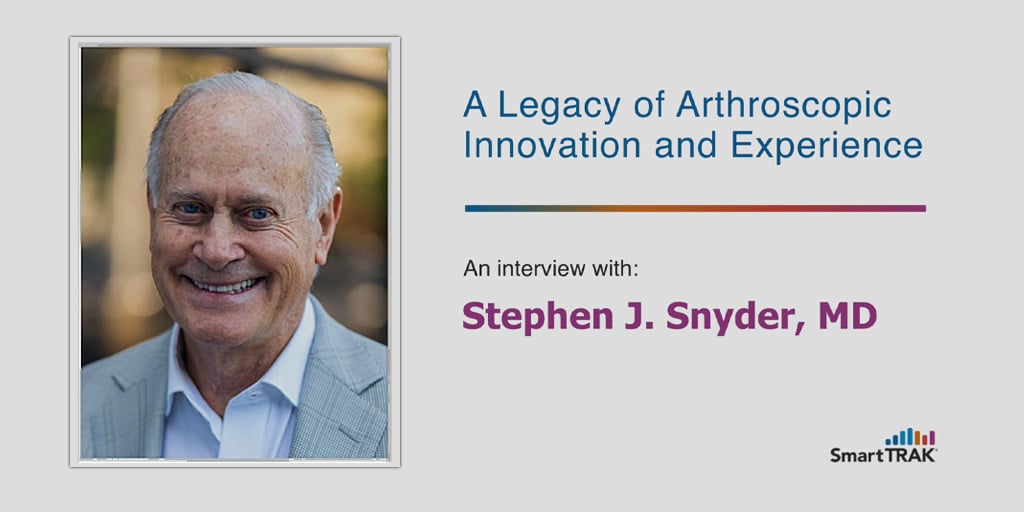 Andrew S. Murtha, MD addresses the controversy surrounding kinematic vs mechanical alignment in total knee arthroplasty.
Andrew S. Murtha, MD addresses the controversy surrounding kinematic vs mechanical alignment in total knee arthroplasty.
Since the introduction of kinematically aligned knee arthroplasty in the mid-2000s, there has been controversy surrounding kinematic (KA) vs mechanical alignment (MA) in total knee arthroplasty (TKA). Kinematic alignment in total knee arthroplasty (TKA) attempts to restore natural limb alignment, maintaining the natural kinematic axis and ligament balance of the patient's knee. In contrast, the classic method of mechanical alignment aims to create a neutral hip-knee-ankle (HKA) axis. Advocates for KA say the technique intended to mimic a patient’s natural knee alignment will result in a more natural feeling and functioning knee. SmartTRAK had the opportunity to interview Andrew S. Murtha, MD regarding the growing interest in KA, what is driving this interest and what the future holds for KA vs MA with feedback from Benjamin Stronach, MD, associate professor at the University of Arkansas for Medical Sciences. Dr. Murtha is a board-certified orthopedic surgeon who is currently an adult reconstruction fellow at Houston Methodist Hospital. He is also a member of the American Association of Hip and Knee Surgeons’ (AAHKS) committee on Patient and Public Relations.
SmartTRAK: What has been your experience with kinematic alignment in total knee arthroplasty?
Andrews S. Murtha, MD: Kinematic alignment is a technical strategy in total knee arthroplasty that aims to individualize implant position by replacing only the cartilage and bone lost during the arthritis process. In its truest form, it does not place restrictions on the alignment of the components. I do not use an unrestricted kinematic alignment strategy in my practice, but the concept has expanded parameters for what is considered acceptable implant position.
In your estimation, based on your experience, what percentage of surgeons currently use KA vs mechanical alignment?
AM: In my experience, the majority of orthopedic surgeons use an adjusted mechanical alignment strategy. However, there does seem to be greater acceptance for slightly modifying the bone cuts to accommodate the patient’s native anatomy, thus reducing the need for large soft tissue releases to balance the knee. I would estimate that the percentage of surgeons using a truly unrestricted, caliper-based, resurfacing-type kinematic alignment strategy is relatively low.
What trends are you seeing in clinical practice – is KA increasing, decreasing or staying the same? What do you think is driving or limiting adoption?
AM: In general, interest in the kinematic alignment strategy has grown over the past 15 years. This interest seems to be driven by the knowledge that as many as one in five patients report dissatisfaction following TKA and the recognition that only about 15% of patients have a native knee that is in mechanical alignment with a neutral joint line. As such, kinematic alignment has been proposed as a strategy to restore patients to their native knee alignment with hopes of improving satisfaction. The interest in this alignment strategy has also occurred during a rapid expansion in the use of technology and robotics during knee replacement surgery, which provides more information and more accurate alignment to allow for a more individualized approach.
How do surgeons choose an alignment strategy?
AM: The alignment strategy employed in total knee arthroplasty is primarily dictated by the surgeon’s experience and preference. Many surgeons employ a mechanical alignment strategy because they want to ensure the greatest longevity of the knee replacement components, and it has been demonstrated in some studies that components placed outside of certain alignment parameters may be at increased risk for failure. Patients are certainly encouraged to ask their surgeon about their alignment strategy, but I would not say that there is one type of ideal patient for a given alignment strategy.
What percentage of the total knee arthroplasty population are potential candidates for KA TKA?
AM: The majority of patients indicated for TKA would be potential candidates. However, there are certain situations that would be considered a contraindication, such as severe deformity, severe post-traumatic osteoarthritis, or an underlying neurological or musculoskeletal condition that requires advanced reconstruction techniques.
What percentage of primary procedures do you estimate are taking place using KA?
AM: We don’t currently have data on this, and I would only be guessing to provide a number. The American Joint Replacement Registry (AJRR) and the American Association of Hip and Knee Surgeons’ practice management survey do not collect information regarding specific alignment strategies employed in TKA.
Can KA be as effective for revision TKA, and if so, what percentage of revision TKAs do you feel could be performed using a KA?
AM: No. Revision knee replacement surgery is a considerably different procedure that addresses issues from infection to implant failure. In revision TKA, the native osseous and ligamentous anatomy has been altered by the primary procedure and subsequent pathology, such that there is often some degree of bone loss following implant removal.
Do you or would use KA for revision cases, and if not, why?
AM: At this time, I would not advocate or perform revision cases with KA alignment as the implants and alignment goals are typically different in a revision surgery compared to primary arthroplasty.
What is the major contraindication for KA TKA?
AM: The most prevalent concern regarding unrestricted kinematic alignment is the risk for implant subsidence and failure, particularly in patients with significant varus or valgus deformities. I would estimate that very few surgeons are comfortable placing implants without some alignment boundaries in these patients.
Do you feel KA will become a “gold standard” for TKA? Why or why not?
AM: At this point, there is not sufficient long-term data to establish that kinematic alignment is the new “gold standard” for TKA. The 2022 clinical practice guideline from the American Academy of Orthopaedic Surgeons (AAOS) on the surgical management of osteoarthritis of the knee noted that there is strong evidence for no difference in composite/functional outcomes or complications between kinematic or mechanical alignment principles in TKA. Its introduction has expanded our understanding of native coronal knee alignment, and there has been some adoption of expanded boundaries for acceptable implant position. It also questions our long-held beliefs that one alignment strategy should be employed for all patients. As we learn more about knee kinematics and TKA outcomes, I anticipate we will move towards a customized knee alignment strategy that is planned for each patient. This has the potential to include some of the tenets of KA alignment. However, the topic remains controversial within the arthroplasty community.
What technologies do you feel will have the most significant impact on surgeon adoption and utilization of KA TKA and why? Are there any specific implant designs or enabling technologies affecting the adoption of this technique, and why?
AM: The rapid expansion of robotic assistance is likely contributing to the increased acceptance of individualized component position in knee replacement, and this technology does offer the opportunity for enhanced pre-operative planning. However, true kinematic alignment does not require the use of intraoperative technology. It utilizes shims and calipers to resect only enough bone to resurface the distal femur and proximal tibia.
With joint replacement procedures migrating to the ASC setting, do you feel KA has advantages over MA, and why?
AM: Both alignment strategies have been successfully implemented in the setting of the ambulatory surgery center. However, technologies that permit enhanced preoperative planning can reduce the amount of instrumentation and inventory required to perform the procedure. The most important considerations when performing TKA in the ASC involve inter-disciplinary coordination on patient selection, anesthetic and analgesic techniques, blood preservation, rapid mobilization, and clinic communication following discharge.
About Andrew S. Murtha, MD
Andrew S. Murtha, MD, a board-certified orthopedic surgeon, is an adult reconstruction fellow at Houston Methodist Hospital. He is also a member of the American Association of Hip and Knee Surgeons’ Patient and Public Relations Committee.
Dr. Murtha earned his medical degree from Saint Louis University School of Medicine, where he graduated at the top of his class and was inducted into the Alpha Omega Alpha Honor Medical Society. He completed his orthopedic surgery residency while on active duty in the US Air Force at the San Antonio Uniformed Services Health Education Consortium (SAUSHEC) between Wilford Hall and Brooke Army Medical Center (BAMC). Following residency, Dr. Murtha served as a staff orthopedic surgeon with the 81st Surgical Operations Squadron at Keesler Air Force Base in Biloxi, MS. He functioned as the orthopaedic surgery medical director and served as an assistant professor of surgery in the Uniformed Services University of Health Sciences (USUHS) F. Edward Herbert School of Medicine. Following the honorable completion of his military service, Dr. Murtha moved to Houston to pursue subspecialty training in hip and knee replacement surgery at the Texas Medical Center.
SmartTRAK is the Medtech industry’s only global Insights-as-a-Service solution for the Orthopedics, Wound Care, Regenerative Medicine and Neuro Therapy markets. SmartTRAK’s propriety methodology turns disparate data from hundreds of sources into powerful insights customers can rely on as the trusted source for strategic decision-making. The SmartTRAK enterprise platform includes rich daily updates, comprehensive market coverage and simple-to-use tools and dashboards for market, product and financial analysis. Customers leveraging the SmartTRAK platform also have direct access to market experts for inquiries and advisory services.
If you would like a demo of what SmartTRAK has to offer and see how we can help increase proficiency, improve productivity and reduce costs for your company, just click here.






